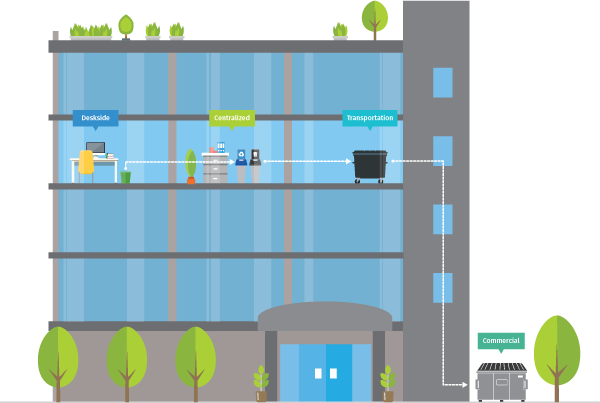For your campus Recycling & Waste Audit, you will need to conduct two separate audits to get the full picture - a Composition Audit and a Station Audit. Based on the size of your campus, you'll need to separate your campus into a number of Program Divisions so that your audit is efficient and manageable.
STEP TWO:
Conduct a Recycling & Waste Audit
Colleges & Universities

Before you hit the ground running, you'll need to complete two full Recycling & Waste Audits and gather as much information as possible about the current state of your program.
A campus recycling & waste audit will give you an understanding of how your recycling program currently fares. You can then use that data to improve your current recycling program and identify potential cost-savings, revenue opportunities and positive environmental impacts.
By separating your campus into divisions, you will be able to more clearly identify problem areas in your program at the beginning and moving forward.
How will I know if my team needs to further segment our divisions?
You want a manageable amount of recycling and waste to retrieve, sort and collect data on. Our rule of thumb is a maximum of one 4 yard container per stream. This is enough to collect accurate data on your division, but not so much that it would take your team an entire day to sort and collect the information you'll need to move forward.
For Colleges & Universities, we suggest considering each building a division and collecting data on it's related outdoor containers. While this may break our rule of thumb outlined above in terms of size and scope, it will allow your team to see which buildings are performing better or worse than others. This also grants the opportunity to create some friendly competition between dormitories, for example, which can have a dramatic positive effect on your recycling rates!
Once you've sorted out whether or not you need to segment your divisions further, you're ready to conduct your first Recycling & Waste Audit.
The goal of this audit is to get a 30,000 ft. look at your current collection program and the general composition of each stream you're collecting.
Before conducting your Composition Audit, you will need to schedule a meeting with your Sustainability Team when everyone is available to attend (easier said than done, right?). Here are some topics that you should cover that will help you plan for your first full audit:
- Conditions
- Roles
- Issues
- Materials
The day you choose should represent a typical day on campus.
You want this audit to run as smoothly as possible.
Clear instructions from the start will avoid confusion on audit day!
If you discuss this in advance, you can figure out what you already have and what you may need to buy. This way you won't be left trying to figure out what you need on the day of the audit.
For your Composition Audit, you'll want to find and map out each Endpoint for your recycling and waste Refuse per program division. For example, if you've setup your Accounting Office building on campus as a division, you'll want to find the last checkpoint for your recycling and waste refuse before it is taken away by your local hauler.
Don't know where to find your refuse's endpoint? Follow the path!

In a typical recycling and waste collection setup there are three or four "locations" where your refuse goes (usually three for outdoor collection and four for indoor collection). For example, "Deskside," "Centralized," "Transportation" and "Commercial" are the four locations in the image above. This means that your recycling and waste makes three or four stops before it is picked up by your hauler. One may find this system a potential lifesaver if you accidently drop your phone in your deskside bin, but when collecting data it makes things more complicated when you're first diving in.

Most often for campuses, the containers your team needs to collect data from for your Composition Audit are found near the shipping bay of each building because that is where they are easily accessible for your hauler.
Once your team has found and mapped the appropriate endpoint of each division, it's time to divide, conquer and get dirty - let's do this!
Heads up! This is not going to be the most fun field trip, but trust us, it'll be worth it. It's going to be sticky, smelly and some bags will be extremely heavy. Make sure you're taking every safety precaution and using any and all safety equipment. If you're in charge of keeping everyone amped up, be sure to let them know they're part of the first exciting step towards #zerowaste for your organization!
After your team has all the materials together, it's time to head over to your mapped endpoints around campus on the date and time you've pre-planned to be the most accurate time to collect data.
At this stage, most Colleges & Universities conduct their audits by going as deep as Stream Composition, which is what we recommend at this point in your sustainability journey.
Conducting your Composition Audit from the endpoint of each division will give your team a great overview of the total stream composition of each of those program divisions. This data can then be used to complete your Station Audit.
Be sure to keep your data in a safe place as you'll need to enter it into the Resource Center at the beginning of Step 3!
Now that your team has a great overview of the current state of your collection program thanks to your Composition Audit, it's time to find key success and problem areas within each division around your campus.
In this section, you and your team will need to map out every centralized Recycling & Waste Collection Station on campus. In the Resource Center tutorial, you or one of your team members created the first division of your campus. This will follow the same process, just on a larger scale as it will be for every division.
Before diving in and starting your Station Audit, we suggest scheduling another meeting with your Sustainability Team when everyone can attend. Here are some topics you should discuss to make sure your Station Audit goes off without a hitch:
- When should you conduct your audit?
- The day you choose should represent a typical day on campus, just like in your Composition Audit.
- What issues could come up during the audit and how can we avoid them?
- Sometimes things inevitably go wrong, but that doesn't mean you shouldn't try to plan for them and prevent them.
- How many people should participate in the audit, and what duties will need to be performed?
- Once again, clear instructions from the start will prevent confusion on audit day!
- What information about the stations and bins will be important to know ahead of time to allow for a smooth audit?
- The last thing you want is to be fumbling around trying to open a bin when you have many more stations to audit.
- What materials do we need for the audit?
- Though not as involved as the Composition Audit, you will still need some supplies to help this audit run smoothly.
Now that every division leader has a template, let's do this...Audit #2!
After your team has all the materials together, it's time for each team to head over to their divisions around campus on the date and time you've pre-planned to be the most accurate time to collect data. When consulting, we at Busch Systems find it easiest to work from the top floor down and finish with the outdoor containers, but it's up to your team to feel out which route is easiest for you.
Remember, this is a Station Audit, so do not consider deskside containers as part of your audit. Centralized stations in hallways, boardrooms, classrooms, cafeterias, etc. are the only containers you want to include.
During the station audit you don't need to worry about removing the contents of each station, as a Capacity Estimate will do the trick. Once you've achieved a higher recycling rate, there will be an option to do an advanced program. At that time you'll be prompted to get more information about each station, but right now we've got lower hanging fruit to eat!
On each template there is a section for notes; if you notice significant stream contamination, signage and labelling issues, poor station placement, etc. - this is a good place to jot down that kind of information.
Once everyone has completed their respective audits for each division, hand in all of the data template sheets to the Coordinator and you're ready for Step 3: Assemble Information!
Composition Audit
A Composition Audit is conducted to determine the types and amounts of refuse in each of your collection streams.
Station Audit
A Station Audit measures the fullness of each bin at every centralized station by capacity, weight, or weight-to-volume.
Program Divisions
A Program Division is a designation you've given a specific area in your organization that allows you to collect data on it independently of other divisions.
Endpoint
The last place where your refuse ends up before it is combined with refuse from another program division or is taken away by your hauler.
Refuse
The term used to describe all waste, recyclables, organic materials, and other items that are being disposed of.
Stream Composition
Stream Composition is the breakdown of the types of items that are found within a stream (ex. glass, plastic).
Material Composition
Material Composition is a breakdown of the types of materials that are found withing a stream (ex. clear glass, green glass, HDPE, LDPE).
Capacity Estimate
A Capacity Estimate is an approximation of how full each container is as a percentage of the whole container.
Did you find this Page helpful?















